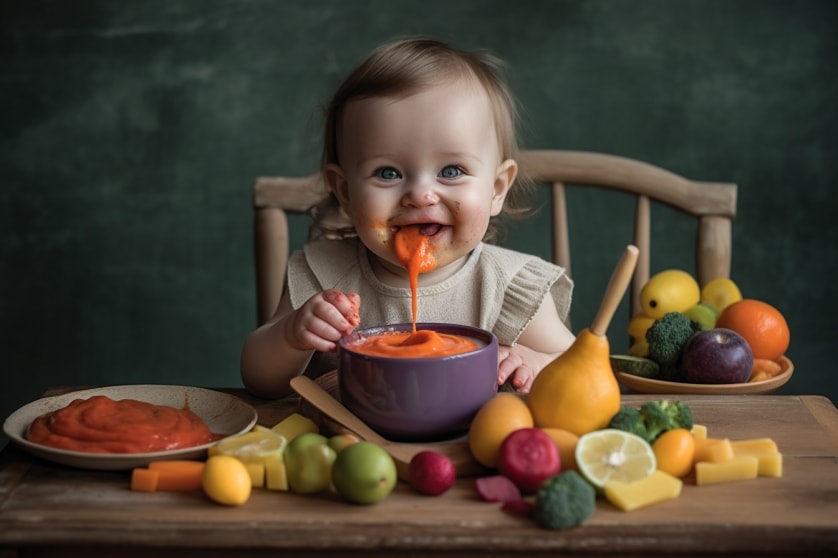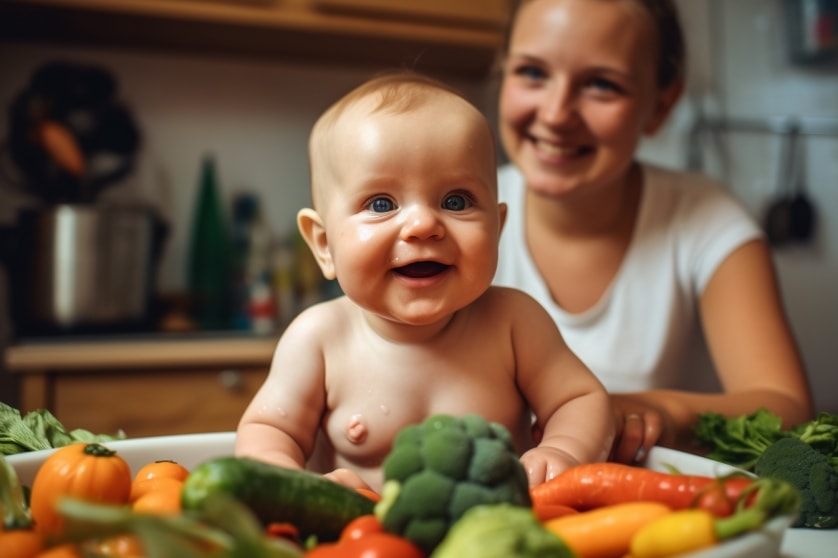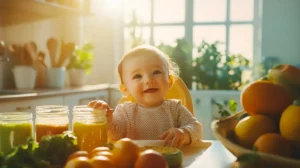Table of Contents
ToggleMaking Homemade Baby Food: A Beginner’s Guide
Are you tired of spending a fortune on store-bought baby food that tastes like cardboard and is packed with preservatives? Or perhaps you’re concerned about the potential health risks associated with processed baby food and want to take control of your baby’s nutrition?
Well, you’ve come to the right place! In this beginner’s guide to making homemade baby food, we’ll explore everything you need to know to get started, from the benefits of homemade baby food to essential tools and equipment, preparation and cooking techniques, food safety tips, and storage and serving suggestions.
Did you know that homemade baby food has been shown to reduce the risk of childhood obesity and improve cognitive development? It’s true! Research has found that babies who are fed homemade baby food are more likely to develop healthy eating habits and have a greater variety of flavors and textures in their diets. Plus, making your own baby food is a great way to save money and reduce waste from packaging and transportation.
But where do you start? With so many different types of blenders and food processors on the market, how do you know which one to choose? And what about choosing the best quality produce or ensuring that your baby’s food is safe and free from harmful bacteria?
Don’t worry, we’ve got you covered! In the sections that follow, we’ll dive into all of these topics and more. Whether you’re a first-time parent or a seasoned pro, you’ll find plenty of tips and tricks to help you make delicious, nutritious homemade baby food that your little one will love.
- Benefits of Making Homemade Baby Food
- Essential Tools and Equipment
- Preparation and Cooking Techniques
- Food Safety Tips
- Storage and Serving Suggestions
So grab your apron and let’s get cooking!

Benefits of Making Homemade Baby Food
There are numerous benefits to making homemade baby food, from providing your little one with fresh and nutritious ingredients to helping them develop healthy eating habits for life. Let’s take a closer look at some of the key benefits of making your own baby food:
- Freshness: One of the most obvious benefits of making homemade baby food is that you have complete control over the ingredients that go into it. Unlike store-bought baby food, which may have been sitting on a shelf for months, homemade baby food is made from fresh, seasonal ingredients that are bursting with flavor and nutrients. This means that your baby will be getting the very best in terms of taste and nutrition, which can help them develop a lifelong love of healthy eating.
- Cost Savings: Another advantage of making your own baby food is that it can save you a significant amount of money in the long run. While the upfront cost of buying a blender or food processor may seem steep, over time, you’ll save money by purchasing fresh ingredients in bulk and preparing them yourself, rather than buying pre-packaged baby food. Plus, by making your own baby food, you’ll be able to eliminate the cost of packaging and transportation, which can add up over time.
- Customization: Making your own baby food also allows you to tailor your recipes to your baby’s tastes and nutritional needs. Whether your little one prefers sweet or savory flavors, you can experiment with different combinations of fruits, vegetables, and grains to find the perfect recipe for them. Plus, if your baby has any allergies or dietary restrictions, you can ensure that their food is free from any potential allergens or harmful ingredients.
- Greater Variety: When you make your own baby food, you’re not limited to the flavors and textures that are available in pre-packaged baby food. Instead, you can introduce your baby to a wide range of fresh, seasonal ingredients that they may not have tried before. This can help them develop a more diverse palate and make them more open to trying new foods as they grow older.
- Control Over Nutritional Content: Making your own baby food also gives you control over the nutritional content of your baby’s meals. Depending on your baby’s age and developmental stage, you can adjust the texture and consistency of their food to suit their needs. Plus, you can ensure that your baby’s food is free from any unnecessary additives or preservatives, which can be found in many pre-packaged baby foods.
- Reduced Waste: Finally, making your own baby food can help you reduce waste and promote sustainability. By using fresh, seasonal ingredients and preparing them yourself, you can eliminate the need for packaging and transportation, which can contribute to a more sustainable food system. Plus, by making your own baby food, you can reduce the amount of food waste that you produce, since you can prepare just the right amount of food for your baby’s needs.
So there you have it! Whether you’re looking to save money, promote healthy eating habits, or reduce your environmental impact, there are plenty of good reasons to make your own baby food. So why not give it a try? Your baby (and your wallet) will thank you!

Essential Tools and Equipment
Making homemade baby food is easier than you might think, and you don’t need a lot of fancy equipment to get started. Here are the essential tools and equipment that you’ll need:
- Blender or Food Processor: A good-quality blender or food processor is the key to making smooth and creamy purees that your baby will love. Look for a model with a large capacity and a powerful motor, so that you can puree even the toughest ingredients with ease. While there are plenty of high-end models on the market, you don’t need to spend a fortune to get a good blender or food processor. Look for a model that fits your budget and has good reviews from other parents.
- Steamer Basket: Steaming is one of the best ways to cook fruits and vegetables for baby food, as it helps to retain their nutrients and natural flavors. To steam your ingredients, you’ll need a steamer basket that fits inside a pot on your stove. Look for a basket that is easy to clean and can hold a variety of different ingredients, from leafy greens to root vegetables.
- Cutting Board and Knife: To prepare your ingredients for steaming and pureeing, you’ll need a good cutting board and a sharp knife. Look for a cutting board that is large enough to hold your ingredients without overcrowding them, and a knife that is comfortable to hold and easy to maneuver. A chef’s knife is a good all-purpose choice for most baby food recipes, but you may also want to invest in a paring knife for smaller ingredients like berries and herbs.
- Storage Containers: Once you’ve pureed your baby food, you’ll need a way to store it safely and conveniently. Look for BPA-free plastic or glass containers with airtight lids that are easy to stack and store in your fridge or freezer. You may also want to invest in silicone freezer trays, which allow you to freeze individual portions of baby food for easy defrosting and serving later on.
- Measuring Cups and Spoons: While you don’t need to be exact when making baby food, measuring cups and spoons can be helpful for getting your recipe just right. Look for a set that includes a variety of sizes, from 1/4 teaspoon to 1 cup, so that you can measure both small and large quantities of ingredients.
While these are the essential tools and equipment that you’ll need to make homemade baby food, there are plenty of other gadgets and accessories on the market that can make the process even easier. From baby food makers that steam and puree your ingredients in one machine to specialized freezer trays and storage bags, there’s no shortage of products to choose from. However, keep in mind that many of these products are unnecessary and can add unnecessary costs to your baby food-making journey. So start with the basics, and add on as needed!
Now that you know the essential tools and equipment needed to make homemade baby food, it’s time to start shopping and experimenting with recipes. Don’t be intimidated by the process – with a little practice and patience, you’ll be whipping up delicious and nutritious baby food in no time!

Preparation and Cooking Techniques
Now that you have your ingredients and tools ready, it’s time to learn the different preparation and cooking techniques for making homemade baby food. Here are some techniques that you can use:
- Steaming: This technique involves placing the vegetables or fruits in a steamer basket and cooking them over boiling water until they become tender. This technique helps to retain the nutrients and flavors of the fruits and vegetables.
- Baking: This technique involves roasting the fruits or vegetables in the oven until they become tender. Baking is a great option for fruits like apples and pears, as it helps to bring out their natural sweetness.
- Boiling: This technique involves cooking the fruits or vegetables in boiling water until they become soft. Boiling is a quick and easy way to cook fruits and vegetables, but it can cause some nutrients to be lost in the cooking process.
- Pureeing: Once the fruits or vegetables have been cooked, you can puree them using a food processor, blender, or immersion blender. Pureeing helps to create a smooth and creamy texture that is easy for babies to eat and digest.
- Freezing: Once you have made your homemade baby food, you can freeze it in small portions for later use. Freezing helps to preserve the nutrients and flavors of the food, and it also makes it easy to have a variety of different foods on hand for your baby.
When it comes to seasoning your baby’s food, it’s best to avoid adding salt or sugar. Instead, you can add small amounts of herbs or spices to add flavor. Some good options include cinnamon, nutmeg, ginger, and thyme.
Remember to always wash your hands, utensils, and equipment thoroughly before preparing your baby’s food. You should also make sure to store your homemade baby food in airtight containers in the refrigerator or freezer to prevent the growth of bacteria.
Making homemade baby food may seem intimidating at first, but with the right tools, techniques, and ingredients, it can be a fun and rewarding experience. Plus, you’ll have the peace of mind of knowing exactly what’s in your baby’s food and where it came from.

Food Safety Tips
When it comes to making homemade baby food, food safety is a top priority. Here are some essential tips to ensure that your baby’s food is safe:
- Wash your hands: Before preparing any food, make sure to thoroughly wash your hands with soap and warm water. This will help prevent the spread of bacteria.
- Wash all produce: Rinse all fruits and vegetables under running water, even if you plan to peel them. This will help remove any dirt or bacteria on the surface.
- Cook food thoroughly: Make sure all food is cooked thoroughly to kill any harmful bacteria. Use a food thermometer to ensure that meat and poultry are cooked to the appropriate temperature.
- Store food properly: Store baby food in airtight containers in the refrigerator or freezer. Use refrigerated baby food within three days and frozen baby food within one month.
- Be aware of potential allergens: Introduce new foods one at a time and watch for any allergic reactions. Common allergenic foods include peanuts, tree nuts, fish, and shellfish.
- Avoid certain foods: Avoid giving your baby honey before the age of one, as it can cause botulism. Also, avoid giving your baby foods that are high in salt, sugar, or preservatives.
By following these food safety tips, you can feel confident that your homemade baby food is safe and healthy for your little one to enjoy.

Storage and Serving Suggestions
Once you have prepared your homemade baby food, it is important to store it properly and serve it safely. Here are some tips for storage and serving:
- Use appropriate storage containers: When storing homemade baby food, use airtight containers made of glass or BPA-free plastic. Avoid using containers made of regular plastic or other materials that may contain harmful chemicals.
- Label and date containers: Make sure to label each container with the type of food and the date it was made. This will help you keep track of how long each batch of baby food has been stored.
- Store in the refrigerator or freezer: Homemade baby food can be stored in the refrigerator for up to three days or in the freezer for up to one month. To thaw frozen baby food, place it in the refrigerator overnight or heat it up on the stove or in the microwave.
- Warm up baby food safely: To warm up baby food, place it in a heat-safe container and heat it up on the stove or in the microwave. Make sure to stir the food and test the temperature before serving it to your baby. Avoid heating up baby food in plastic containers or in the microwave if they contain metal or are not heat-safe.
- Introduce new foods gradually: When introducing new foods to your baby, start with small amounts and gradually increase the portion size over time. This will help your baby get used to new flavors and textures.
- Discard any leftover food: If your baby does not finish a serving of baby food, discard any leftover food instead of saving it for later. Bacteria can grow quickly in leftover baby food and can cause illness.
By following these storage and serving suggestions, you can ensure that your homemade baby food stays fresh and safe for your little one to enjoy. Making your own baby food can be a fun and rewarding experience, and with a little planning and preparation, you can provide your baby with healthy and delicious meals.
Conclusion
Congratulations! You have now learned the basics of making homemade baby food. You now have the knowledge and confidence to create healthy and nutritious meals for your little one. Not only is making your baby’s food at home easy, but it is also cost-effective, eco-friendly, and most importantly, beneficial for your baby’s health.
Remember to always prioritize your baby’s safety by following proper food safety guidelines and storing the food correctly. Experiment with different ingredients and flavor combinations to keep your baby interested and excited about trying new foods. Making homemade baby food is a great way to bond with your baby and show them just how much you care.
Thank you for reading our beginner’s guide to making homemade baby food. We hope you found it informative and helpful. If you have any questions or comments, please feel free to leave them below. Happy cooking!
Want to take your knowledge to the next level? Check out these must-read articles:
- The Transition from Breastmilk or Formula to Solid Foods: A Parent’s Survival Guide
- Managing the Cost of Baby Food: Strategies for Saving Money
Organize your baby’s wardrobe with our baby clothes closet organizer products! Our organizers are designed specifically for baby clothes. Get your baby’s clothes neat and tidy with our selection of organizers – shop now!
Hey there, are you craving a fresh perspective? Look no further! Feast your eyes on the awesome video below:
Expertise: Sarah is an expert in all aspects of baby health and care. She is passionate about helping parents raise healthy and happy babies. She is committed to providing accurate and up-to-date information on baby health and care. She is a frequent speaker at parenting conferences and workshops.
Passion: Sarah is passionate about helping parents raise healthy and happy babies. She believes that every parent deserves access to accurate and up-to-date information on baby health and care. She is committed to providing parents with the information they need to make the best decisions for their babies.
Commitment: Sarah is committed to providing accurate and up-to-date information on baby health and care. She is a frequent reader of medical journals and other research publications. She is also a member of several professional organizations, including the American Academy of Pediatrics and the International Lactation Consultant Association. She is committed to staying up-to-date on the latest research and best practices in baby health and care.
Sarah is a trusted source of information on baby health and care. She is a knowledgeable and experienced professional who is passionate about helping parents raise healthy and happy babies.
- The Circadian Connection: Syncing Your Baby’s Day-Night Rhythms - June 27, 2025
- Mother-to-Mother Mentorship: Reviving Traditional Wisdom Sharing - June 26, 2025
- The Village That Wasn’t: Creating Community Support Systems - June 25, 2025



